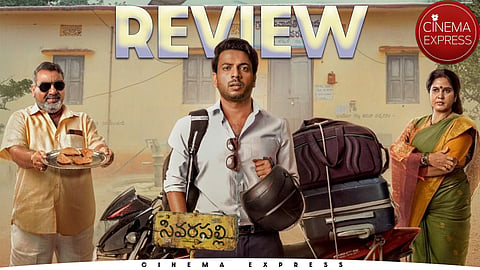Sivarapalli Series Review: A faint echo of Panchayat
Sivarapalli review(2 / 5)
When you start watching Sivarapalli after experiencing Panchayat, comparisons are inevitable. Although it is difficult to watch the series with an intention to not draw parallels, gradually you shake it off. Now, Sivarapalli isn’t exactly underwhelming but the glaring flaw is the acting. Look beyond the original's quiet and laid-back writing, what lingers are Jitendra Kumar’s beautifully subdued anguish, Raghubir Yadav’s effortless physical comedy, and Neena Gupta’s commanding presence. There are shows made from great writing and there are ones made because of fine actors and Panchayat is a mesmerising example of the latter. The show thrived on its cast’s understated brilliance. The actors’ lazy, unpolished delivery mirrored life’s ordinariness so convincingly that the show calmed you.
Director: Bhaskhar Maurya
Cast: Muralidhar Goud, Rag Mayur, Rupa Lakshmi, Uday Gurrala, Sunny Palle, Pavani Karanam
Sivarapalli tries to emulate this magic but falters with its leads. Rag Mayur spends the entire series stuck in an overdone “tired-of-this-village” act, you can’t help but appreciate Jitender Kumar for keeping it so simple. Another huge mismatch is Rupa Lakshmi’s Sarpanch. After the breezy captain-in-command that is Neena Gupta, it’s yet again impossible to grasp this performance. Admittedly, Panchayat set a high bar that is hard to match, in terms of performances as well. So, let’s go beyond the performances now.
Let us talk about the scenes. Because Panchayat was always about the screenplay, rather than the story. Those small, evocative moments, when the old Sarpanch tries to find his keys in the square foot area where he relieved himself, there was brutal irony expressed in the simplest way—The key to progress has always been in sh*t because of lazy Nethas. The show’s calming genius was in the fact that it gave you a million reasons to judge those people but gradually, it made you love them. Because they were essentially not bad people. Sivarapalli is commendable for finding those kind, naive people again with this adaptation work. The Telangana nativity is another strong suit.
There is a genuine attempt here with the cultural rooting. Telangana nativity and cultural representation are quite simple to bring if you grew up in such households. Sivarapalli succeeds in writing the laidback Telangana villager who is momentarily happy. Because of this clear understanding of the culture, the show sits easy with you. Sivarapalli tries its best to flow in moments after it's done chasing the original. Once the dust of imitation settles, you see glimpses of the soul it wants to display.
The true hero of the show—in the lingo of Sivarapalli, the mutton curry of this show—is the original sound design by Nagarjuna Thallapalli. You can never go wrong with this man’s mastery over sound immersiveness. It’s simply the sole hook factor to make it through the first season of the series. Nagarjuna’s sound and Muralidhar Goud’s typical Telangana uncle. Goud, of course, gained his fame from DJ Tillu, but I contend that the man has mostly played himself or at least an extended version. Because as I said, it’s easy to bring out the laid-back Telangana man. And because Goud comes from a familiar place, he can pull off the Sarpanch effortlessly.
Another beautiful thing sorely missed in Sivarapalli is the drone cinematography, delivered with delicious earthy music by Anurag Saikia in the original. There are familiar tunes, composed by Sinjith Yerramilli. However, the series lacks a sense of being rooted in terms of its musical inspiration. You see, Panchayat starts as a pastiche of the evergreen film Swades. The gene in those humbling tunes composed by Rahman for Swades has been the stimulus for Panchayat’s score. In this one, when a friend character utters Mahesh Babu’s Maharshi as a role model for the protagonist, you instantly know that this is not a positive sign. It’s not the same kind of uplifting inspiration for the Indian youth anymore.
Sivarapalli has its moments of charm and a soothing touch reminiscent of its Hindi predecessor. If you’re looking for a gentle narrative, it’s worth a watch. But I’d still recommend experiencing the original first. Ultimately, both shows share a central truth: Life offers its nectar, only after you accept where you are and just flow.
P.S: It’s time to stop these dead remakes of a hit in one language to another. After all, streaming platforms pushed people to go beyond language with subtitles and now, these remakes are simply a desperate, low-effort attempt at pleasing the regional markets.


